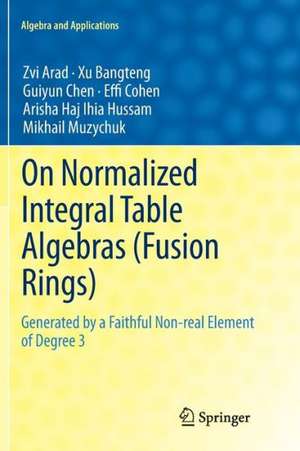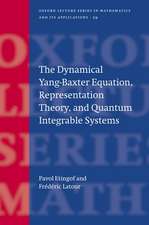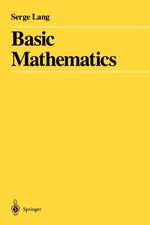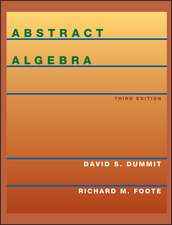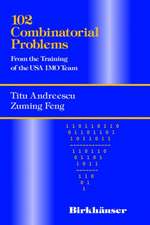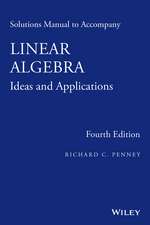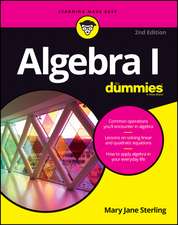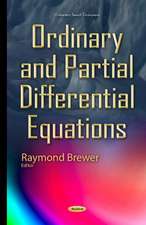On Normalized Integral Table Algebras (Fusion Rings): Generated by a Faithful Non-real Element of Degree 3: Algebra and Applications, cartea 16
Autor Zvi Arad, Xu Bangteng, Guiyun Chen, Effi Cohen, Arisha Haj Ihia Hussam, Mikhail Muzychuken Limba Engleză Paperback – 27 noi 2013
| Toate formatele și edițiile | Preț | Express |
|---|---|---|
| Paperback (1) | 368.40 lei 38-45 zile | |
| SPRINGER LONDON – 27 noi 2013 | 368.40 lei 38-45 zile | |
| Hardback (1) | 394.87 lei 6-8 săpt. | |
| SPRINGER LONDON – 20 iul 2011 | 394.87 lei 6-8 săpt. |
Din seria Algebra and Applications
- 18%
 Preț: 898.72 lei
Preț: 898.72 lei -
 Preț: 379.09 lei
Preț: 379.09 lei -
 Preț: 359.64 lei
Preț: 359.64 lei -
 Preț: 359.96 lei
Preț: 359.96 lei - 20%
 Preț: 394.09 lei
Preț: 394.09 lei - 24%
 Preț: 685.39 lei
Preț: 685.39 lei - 24%
 Preț: 643.24 lei
Preț: 643.24 lei -
 Preț: 371.58 lei
Preț: 371.58 lei - 24%
 Preț: 652.84 lei
Preț: 652.84 lei - 24%
 Preț: 927.59 lei
Preț: 927.59 lei -
 Preț: 404.89 lei
Preț: 404.89 lei - 24%
 Preț: 2000.43 lei
Preț: 2000.43 lei - 24%
 Preț: 591.77 lei
Preț: 591.77 lei - 24%
 Preț: 829.44 lei
Preț: 829.44 lei - 15%
 Preț: 583.78 lei
Preț: 583.78 lei - 15%
 Preț: 707.13 lei
Preț: 707.13 lei - 24%
 Preț: 640.00 lei
Preț: 640.00 lei - 18%
 Preț: 900.49 lei
Preț: 900.49 lei - 18%
 Preț: 1110.09 lei
Preț: 1110.09 lei - 18%
 Preț: 795.50 lei
Preț: 795.50 lei - 18%
 Preț: 780.68 lei
Preț: 780.68 lei - 15%
 Preț: 670.30 lei
Preț: 670.30 lei - 18%
 Preț: 887.86 lei
Preț: 887.86 lei -
 Preț: 416.64 lei
Preț: 416.64 lei -
 Preț: 395.63 lei
Preț: 395.63 lei -
 Preț: 390.08 lei
Preț: 390.08 lei - 15%
 Preț: 644.30 lei
Preț: 644.30 lei
Preț: 368.40 lei
Nou
Puncte Express: 553
Preț estimativ în valută:
70.50€ • 75.38$ • 58.78£
70.50€ • 75.38$ • 58.78£
Carte tipărită la comandă
Livrare economică 14-21 aprilie
Preluare comenzi: 021 569.72.76
Specificații
ISBN-13: 9781447127031
ISBN-10: 144712703X
Pagini: 284
Ilustrații: X, 274 p.
Dimensiuni: 155 x 235 x 15 mm
Greutate: 0.41 kg
Ediția:2011
Editura: SPRINGER LONDON
Colecția Springer
Seria Algebra and Applications
Locul publicării:London, United Kingdom
ISBN-10: 144712703X
Pagini: 284
Ilustrații: X, 274 p.
Dimensiuni: 155 x 235 x 15 mm
Greutate: 0.41 kg
Ediția:2011
Editura: SPRINGER LONDON
Colecția Springer
Seria Algebra and Applications
Locul publicării:London, United Kingdom
Public țintă
ResearchCuprins
Introduction.- Splitting the Main Problem into Four Sub-cases.- A Proof of a Non-existence Sub-case (2).- Preliminary Classification of Sub-case (2).- Finishing the Proofs of the Main Results
Recenzii
From the reviews:
“In the book under review the authors’ aim is to classify normalized integral table algebras generated by a faithful non-real element of degree 3. To do this several cases appear and the authors examine each case carefully to prove the existence of the table algebra in question. … is well organized and will be beneficial to many researchers of finite group theory.” (Mohammad-Reza Darafsheh, Mathematical Reviews, Issue 2012 f)
“In the book under review the authors’ aim is to classify normalized integral table algebras generated by a faithful non-real element of degree 3. To do this several cases appear and the authors examine each case carefully to prove the existence of the table algebra in question. … is well organized and will be beneficial to many researchers of finite group theory.” (Mohammad-Reza Darafsheh, Mathematical Reviews, Issue 2012 f)
Textul de pe ultima copertă
The theory of table algebras was introduced in 1991 by Z. Arad and H.Blau in order to treat, in a uniform way, products of conjugacy classes and irreducible characters of finite groups. Today, table algebra theory is a well-established branch of modern algebra with various applications, including the representation theory of finite groups, algebraic combinatorics and fusion rules algebras.
This book presents the latest developments in this area. Its main goal is to give a classification of the Normalized Integral Table Algebras (Fusion Rings) generated by a faithful non-real element of degree 3. Divided into 4 parts, the first gives an outline of the classification approach, while remaining parts separately treat special cases that appear during classification. A particularly unique contribution to the field, can be found in part four, whereby a number of the algebras are linked to the polynomial irreducible representations of the group SL3(C).
This book will be of interest to research mathematicians and PhD students working in table algebras, group representation theory, algebraic combinatorics and integral fusion rule algebras.
This book presents the latest developments in this area. Its main goal is to give a classification of the Normalized Integral Table Algebras (Fusion Rings) generated by a faithful non-real element of degree 3. Divided into 4 parts, the first gives an outline of the classification approach, while remaining parts separately treat special cases that appear during classification. A particularly unique contribution to the field, can be found in part four, whereby a number of the algebras are linked to the polynomial irreducible representations of the group SL3(C).
This book will be of interest to research mathematicians and PhD students working in table algebras, group representation theory, algebraic combinatorics and integral fusion rule algebras.
Caracteristici
Offers current results through well-established methodology. Generalizes the finite linear groups of degree 3, yet remains broad in scope. Written by the world's leading expert in this area. Includes supplementary material: sn.pub/extras
